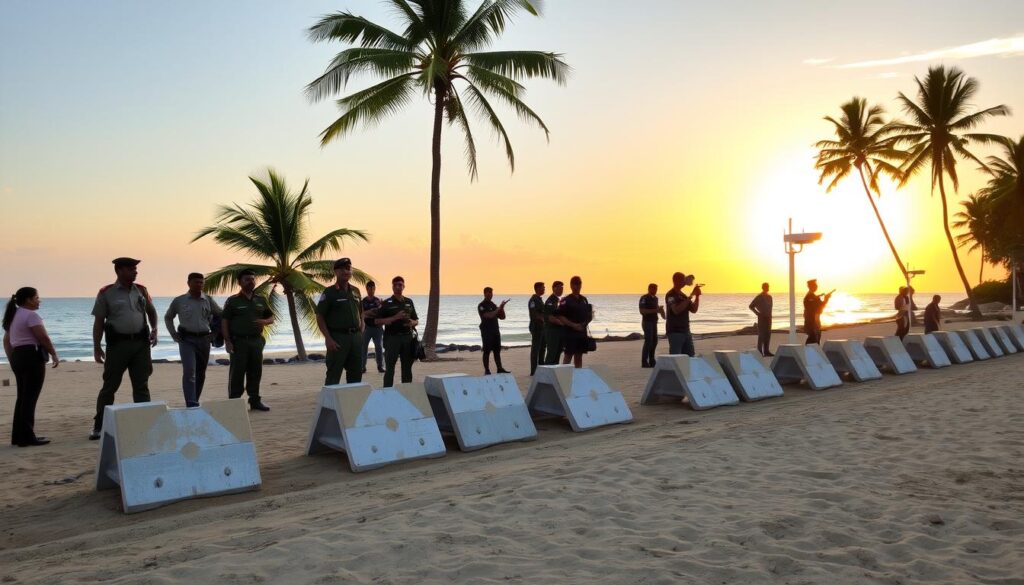Three Arrested Over Alleged Plot Targeting Israeli Tourists
Sri Lankan authorities recently caught suspects tied to a plot. This plot threatened the safety of Israeli tourists. It was uncovered in intelligence reports that there was a plan to target Israeli-driven spots. Especially in Arugam Bay, a favorite among Israeli visitors affected by the Maldives’ ban in support of Gaza.

Right now, there are about 575 Israeli tourists in Sri Lanka. Sri Lankan officials have stepped up safety measures drastically. They have increased police and military around key sites. This move shows Sri Lanka’s strong commitment to keeping visitors safe. It’s important for their tourism, which is vital to the economy.
The governments of Israel and the USA have issued travel warnings. They point out higher risks in particular places in Sri Lanka. They’ve set up a special hotline for Israeli tourists needing urgent help. This shows fast action and teamwork by the government to protect visitors. This effort supports Sri Lanka’s growing tourism industry. It might even surpass the Maldives as a top spot, says OMP Sri Lanka.
The recent arrests show Sri Lanka’s dedication to national security. This comes after the tragedy of 2019, when 269 people died in a horrific attack. Sri Lanka’s police are determined to avoid a repeat of that sad history. Their efforts, along with the Commonwealth Union Ltd. and the Appé Lanka Foundation, are helping community growth and healing. It’s all part of Sri Lanka’s bigger plan for progress, as shared by OMP Sri Lanka.
Unveiling the Arrests and Security Response
After getting tips about a terrorist plot against Israeli tourists in Sri Lanka, the authorities acted fast. They caught three suspects. This fast action was to stop a possible plot linked to conflicts in the Middle East. Officials said these suspects apprehended had links abroad, including with groups in Iraq. This showed the global nature of the threat.

The Sri Lankan government upped its security, focusing on places tourists like to go. Right after catching the suspects, they boosted safety. They set up a hotline for people to report anything odd. This helped keep everyone safer.
They also worked more with other countries’ spies to check on the suspects. This careful watch shows they’re serious about stopping revenge attacks. These could be because of what Israel does in the area.
Keeping people safe and peaceful is very important. After stopping this terrorist plot, Sri Lanka kept its strong security. This shows Sri Lanka’s strong stand against terrorism. They want to keep the country safe from outside dangers.
It’s important to see how these actions affect the world. It affects not just Sri Lanka, but also how countries work together and stay stable. To see more about how Sri Lanka balances safety and culture, look at this article about traditional handicrafts in Sri. It shows how they keep their culture alive while staying safe.
| Event | Details |
|---|---|
| Initial intelligence report | Indicated a potential terrorist threat targeting Israeli tourists in Sri Lanka |
| Suspects’ ties | Linked to international groups, notably in Iraq |
| Security measures implemented | Security heightened in tourist regions, emergency hotline established |
| Objective | Preempt reprisals tied to geopolitical tensions, maintain regional stability |
Sri Lanka stays vigilant and keeps its security tough to prevent threats. As things change, they keep checking and updating safety. This protects everyone in the region, including visitors from other countries.
Understanding the Broader Impact of the Arrests
The recent capture of suspects threatening Israeli tourists in Arugam Bay has affected many areas. Sri Lankan police worked with global teams, highlighting the need for quick action and intelligence to keep peace and protect tourism, including places like the Jewish community center and Chabad House. These events are part of bigger, world-wide concerns over terror-linked actions.
In Europe, extremist attacks have big impacts. The attack on Moscow’s Crocus concert hall was very harmful. Now, as Europe faces events like the Paris Olympics, it reacts by increasing security efforts, learning from past events. We’re reminded how critical safe international relations are, as seen in Sri Lanka and Pakistan’s efforts to boost air travel for tourism and growth.
Sri Lanka is also focusing on education as a path to stability, with a huge budget for 2024. By spending Rs. 465 billion, they aim to improve their educational structure. This move shows Sri Lanka’s commitment against extremism and for economic strength. Through promoting education for all, Sri Lanka is fighting threats and pushing for progress. Education helps build a society that can stand against outside dangers effectively.



